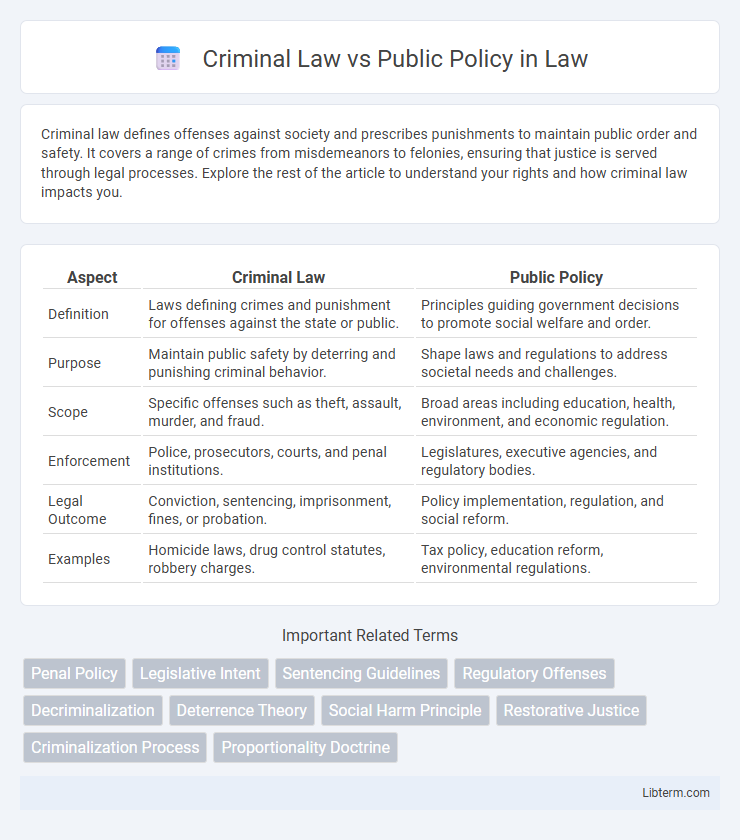Criminal law defines offenses against society and prescribes punishments to maintain public order and safety. It covers a range of crimes from misdemeanors to felonies, ensuring that justice is served through legal processes. Explore the rest of the article to understand your rights and how criminal law impacts you.
Table of Comparison
| Aspect | Criminal Law | Public Policy |
|---|---|---|
| Definition | Laws defining crimes and punishment for offenses against the state or public. | Principles guiding government decisions to promote social welfare and order. |
| Purpose | Maintain public safety by deterring and punishing criminal behavior. | Shape laws and regulations to address societal needs and challenges. |
| Scope | Specific offenses such as theft, assault, murder, and fraud. | Broad areas including education, health, environment, and economic regulation. |
| Enforcement | Police, prosecutors, courts, and penal institutions. | Legislatures, executive agencies, and regulatory bodies. |
| Legal Outcome | Conviction, sentencing, imprisonment, fines, or probation. | Policy implementation, regulation, and social reform. |
| Examples | Homicide laws, drug control statutes, robbery charges. | Tax policy, education reform, environmental regulations. |
Introduction to Criminal Law and Public Policy
Criminal law defines offenses against the state, establishing penalties to maintain social order and protect citizens. Public policy encompasses the principles guiding government actions and legislative measures aimed at promoting societal welfare and justice. The intersection of criminal law and public policy shapes legal frameworks that balance individual rights with community safety and ethical standards.
Defining Criminal Law: Scope and Purpose
Criminal law defines behaviors classified as offenses against the state, outlining penalties such as imprisonment, fines, or community service to maintain public order and protect citizens. Its scope includes crimes like theft, assault, and fraud, enforcing societal norms through legislative statutes and judicial decisions. The primary purpose of criminal law is deterrence, punishment, rehabilitation, and ensuring justice by upholding legal standards that safeguard public safety and moral conduct.
Understanding Public Policy: Key Concepts
Public policy in criminal law serves as a framework guiding legislative and judicial decisions to promote societal welfare and justice. It encompasses principles such as deterrence, rehabilitation, and the protection of public safety, shaping laws to balance individual rights with community interests. Understanding these key concepts helps clarify how public policy influences the creation, interpretation, and enforcement of criminal statutes.
Historical Evolution of Criminal Law and Public Policy
The historical evolution of criminal law is rooted in ancient codes such as Hammurabi's Code, which established early principles of justice and punishment aimed at maintaining social order. Public policy has evolved alongside criminal law to address the societal needs and values reflected in legal reforms, influencing crime prevention and regulatory frameworks. Over centuries, the dynamic interplay between criminal law and public policy has shaped modern legal systems to balance individual rights with collective security.
Objectives: Punishment vs. Social Welfare
Criminal law primarily aims to punish offenders through penalties such as imprisonment, fines, or community service to uphold justice and deter crime. Public policy focuses on promoting social welfare by addressing societal issues, preventing harm, and ensuring the well-being of the community through regulations and programs. The objective of criminal law centers on retribution and public safety, while public policy emphasizes long-term social benefits and equity.
Legal Frameworks: Statutes and Regulatory Principles
Criminal law is governed by statutes that define offenses and prescribe punishments to maintain public order and safety. Public policy encompasses regulatory principles embedded in administrative laws aimed at guiding governmental actions to achieve societal goals. Both legal frameworks intersect by using statutory provisions and regulatory guidelines to balance individual rights and collective welfare.
Intersection and Conflicts between Criminal Law and Public Policy
Criminal law and public policy intersect when legal statutes are crafted to reflect societal values and promote public welfare through deterrence and punishment. Conflicts arise where criminal law enforcement may clash with evolving public policies, such as in cases involving drug legislation or privacy rights, creating tensions between legal rigidity and policy innovation. Balancing these conflicts requires continual reassessment of criminal statutes to ensure alignment with the broader goals of social justice and public interest.
Impact on Society: Social Control Mechanisms
Criminal law serves as a primary social control mechanism by defining illegal behaviors and prescribing penalties that deter harmful conduct, thereby maintaining public order and protecting individual rights. Public policy shapes the framework within which criminal laws are created and enforced, reflecting societal values and priorities to address emerging social issues effectively. Together, these systems influence societal behavior by promoting justice, safety, and the common good through established legal norms and regulatory measures.
Contemporary Issues and Debates
Criminal law and public policy intersect in contemporary debates surrounding mass incarceration, sentencing reforms, and restorative justice approaches that challenge traditional punitive measures. Issues such as the decriminalization of certain offenses, the impact of mandatory minimum sentences, and equity in law enforcement highlight ongoing tensions in balancing public safety with social justice goals. Emerging discussions emphasize data-driven policies, community-based interventions, and the role of systemic bias in shaping both criminal law and public policy outcomes.
Conclusion: Balancing Justice and Public Interest
Criminal law serves to uphold justice by punishing wrongdoing and protecting societal order, while public policy aims to promote the common good through regulations that reflect societal values. Striking a balance between enforcing criminal statutes and advancing public policy is essential to ensure fair legal outcomes without undermining social progress. Effective legal frameworks harmonize criminal accountability with public interest to foster a just and equitable society.
Criminal Law Infographic

 libterm.com
libterm.com